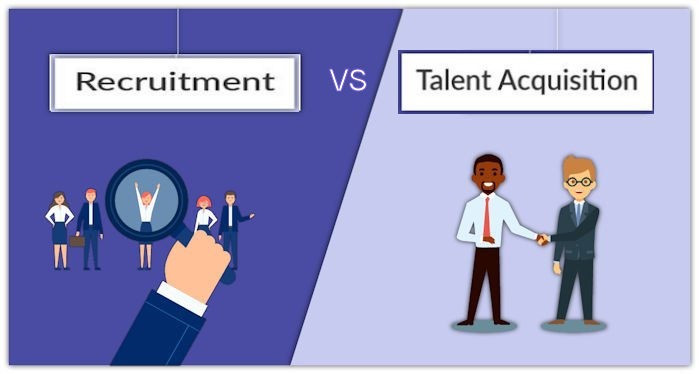Recruitment or talent acquisition – are there any significant differences?
Before attempting to answer this, we need to acknowledge that people often confuse the two. It’s not that surprising when they both overlap and in fact, you can’t have talent acquisition without recruitment.
Talent acquisition tends to have a far wider perspective than traditional recruitment, which can be set in its ways.
Still, recruitment is the go-to process for getting a job vacancy filled quickly. In this article, we’ll examine the differences between each approach.
What is Recruitment?
Recruitment is about filling an existing vacancy. As the vacancy exists, recruiters tend to know exactly what they need from candidates. They will probably have a well-established record of the tasks required to fulfill the role and can use this for their job postings.
Normally, there is an established procedure for seeking, evaluating, and ultimately hiring candidates. This typically involves:
- Posting a job online or on social media, and/or in print
- Receiving resumes and cover letters
- Screening the applications to create a shortlist for interviews
From there, it leads to selecting the candidate who appears best for the firm. The process could also involve testing applicants or having a period of probation.
It can take weeks. While those weeks might seem grueling, especially if you’re using spreadsheets to manage the process rather than a dedicated recruitment software, it’s nonetheless short-term.
The main purpose behind this is to solve an immediate issue quickly.
In this case, that’s filling a current job opening. However, when it comes to filling an unexpected vacancy quickly, the tried-and-tested recruitment methods are usually best for getting fast results.
What is Talent Acquisition?
Compared to standard recruiting, talent acquisition is more long-term and forward-thinking.
The main purpose behind it is to help the company grow by anticipating what the future will demand. It considers and focuses more on the future needs rather than the immediate and short-term needs.
A HR professional in talent acquisition considers how the company needs to adapt to disruption, technology, and trends rather than filling an existing role. By observing current staffing trends, talent acquisition professionals will make the most of opportunities to attract and secure the best talent.
Recruitment can fill a gap to keep the company working, whereas talent acquisition involves finding the future leaders of a business. In particular, they’ll focus on high-level skill sets that can help the company move towards the right direction.
Unlike traditional recruiting, talent acquisition takes longer. There are a few things you can do however, to improve the process.
Typically, it’s far more suited to attracting specialists and business leaders. It’s also frequently used by businesses in the IT industry that require specific skills and experts who can predict rapid change within the industry.
More Notable Differences Between Recruitment and Talent Acquisition
Talent acquisition is more flexible and dynamic as it foregoes a standard procedure in favor of various methods and tools.
This includes networking, referrals, and social media – all in order to achieve strategic aims. For example, one of its main aims is to make a company more attractive to candidates.
Furthermore, it considers which individuals are best for the company and how the company can be better for its employees. Because of this, it’s more likely to consider the ambitions, attitude, and philosophy of the potential candidate in addition to his or her experience and qualifications.
Businesses find that this is ideal for filling niche roles or for finding people to take on entirely new positions within a company. If you don’t know exactly what a role will entail because it doesn’t exist yet, talent acquisition would be an excellent approach.
As the process involves brand management and creating an attractive culture, it can connect a new business to the right applicant who matches your needs.
It’s also worth noting that the term talent acquisition is somewhat misleading because it also involves retaining staff. The drive behind building talent is to create an environment where people will thrive and are less likely to leave.
In contrast to traditional recruiting, it does not end when a hire signs a contract and turns up on day one. It will also continue during an effective onboarding process to improve staff retention and productivity.
Should an employee decide to leave the firm, a good strategy would ensure that the company learns why the employee wanted to quit. Using this information, you can form the basis of metrics and analytics to help a business understand how they’re doing and how they can improve their staff retention.
Recruitment vs. Talent Acquisition: The Final Verdict
So, recruitment vs. talent acquisition: is one better than the other?
They both have different purposes and aim to fulfill different needs but they are not mutually exclusive. The best strategy for firms involves optimizing both areas to cover all the bases.
HR can enhance the recruiting process and make it more sustainable by learning from talent acquisition.
By focusing on the value of employees and investing in brand management, recruiters can attract higher-quality candidates. On top of that, you would have a better chance of retaining them.
But, it won’t be as effective without the implementation of standard recruitment.
If you can’t fill an urgent job vacancy or manage business growth for the long run, it won’t be sustainable. The best decision would be to adopt a balance between short-term and long-term thinking.
Conclusion
The right recruiting software can refine the entire recruitment and talent acquisition process by tracking and automating as many tasks as possible. It would also enable you as a recruiter and HR professional to move more quickly, keep tabs on candidates, and track the results behind your effort.
If you have any further questions or queries, please don’t hesitate to get in touch!


